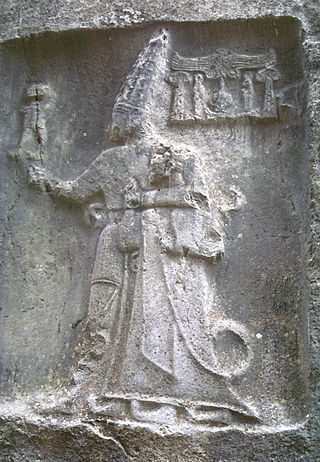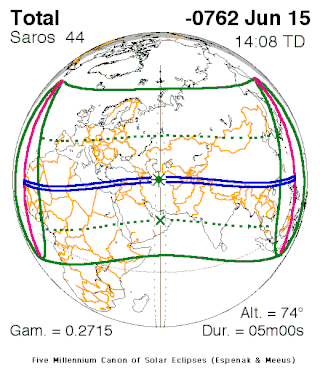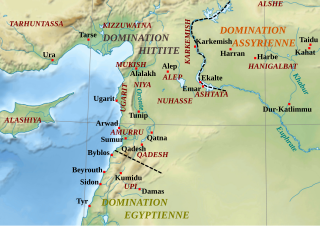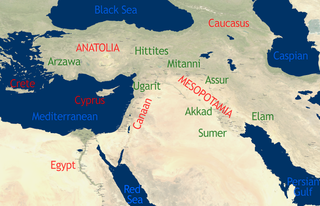
Mitanni, earlier called Ḫabigalbat in old Babylonian texts, c. 1600 BC; Hanigalbat or Hani-Rabbat in Assyrian records, or Naharin in Egyptian texts, was a Hurrian-speaking state in northern Syria and southeast Anatolia with Indo-Aryan linguistic and political influences. Since no histories, royal annals or chronicles have yet been found in its excavated sites, knowledge about Mitanni is sparse compared to the other powers in the area, and dependent on what its neighbours commented in their texts.

Šuppiluliuma I, also Suppiluliuma or Suppiluliumas was an ancient Hittite king.

Šuppiluliuma II, the son of Tudḫaliya IV, was the last certain great king of the New Kingdom of the Hittite Empire, ruling c. 1207–1178 BC, contemporary with Tukulti-Ninurta I of the Middle Assyrian Empire. The name of the king, unlike that of his ancestor Šuppiluliuma I, is usually spelled Šuppiluliama in the contemporary primary sources.
Mursili II was a king of the Hittite Empire c. 1330–1295 BC or 1321–1295 BC.
Ḫattušili II was a possible Hittite great king during the 15th or 14th century BC, perhaps reigning c. 1440–c. 1425 BC.

Tudhaliya IV was a king of the Hittite Empire, and the younger son of Hattusili III. He reigned c. 1245–1215 BC or c. 1237–1209 BC. His mother was the great queen, Puduhepa.

Hattusili I was a king of the Hittite Old Kingdom. He reigned ca. 1650–1620 BC, or ca. 1640–1610 BC(low middle chronology).
Zannanza was a Hittite prince, son of Suppiluliuma I, king of the Hittites. He is best known for almost becoming the Pharaoh of Egypt, and because his death caused a diplomatic incident between the Hittite and Egyptian Empires, resulting in warfare.

Tudḫaliya III, with the additional Hurrian name Tašmi-Šarri, was a Hittite great king in Anatolia during the Late Bronze in the 14th century BC, in c. 1380–1350 BC. He was the son and successor of Arnuwanda I and the predecessor, father-in-law, and adoptive father of Šuppiluliuma I.
Tarḫuntašša was a Bronze Age city in south-central Anatolia mentioned in contemporary documents. Its location is unknown. The city was the capital of the Hittite Empire for a time and later became a regional power in its own right. The kingdom controlled by the city is known by the same name and its approximate borders are known from texts.
Kupanta-Kurunta was a king of Mira known for his involvement in Hittite geopolitics. He was born in the 1330s or 1320s BC at Mira in western Anatolia, in one of the princely families. His father joined a coup against king Mašḫuiluwa. The Hittite king Suppiluliuma I married Mašḫuiluwa to his daughter Muwatti and reinstalled him. Kupanta-Kurunta's father apparently died or was exiled soon after. Mašḫuiluwa then asked Suppiluliuma's successor Mursili II if he could adopt Kupanta-Kurunta as a son.

The Assyrian eclipse, also known as the Bur-Sagale eclipse, is a solar eclipse recorded in Assyrian eponym lists that most likely dates to the tenth year of the reign of king Ashur-dan III. The eclipse is identified with the one that occurred on 15 June 763 BC in the proleptic Julian calendar.

Nuhašše, was a region in northwestern Syria that flourished in the 2nd millennium BC. It was east of the Orontes River bordering Aleppo (northwest) and Qatna (south). It was a petty kingdom or federacy of principalities probably under a high king. Tell Khan Sheykhun has tenatively been identifed as kurnu-ḫa-šeki.
Dakhamunzu is the name of an Egyptian queen known from the Hittite annals The Deeds of Suppiluliuma, which were composed by Suppiluliuma I's son Mursili II. The identity of this queen has not yet been established with any degree of certainty and Dakhamunzu has variously been identified as either Nefertiti, Meritaten or Ankhesenamen. The identification of this queen is of importance both for Egyptian chronology and for the reconstruction of events during the late Eighteenth Dynasty.

The chronology of the ancient Near East is a framework of dates for various events, rulers and dynasties. Historical inscriptions and texts customarily record events in terms of a succession of officials or rulers: "in the year X of king Y". Comparing many records pieces together a relative chronology relating dates in cities over a wide area.

Hapalla, also written as Haballa, was a kingdom in central-western Anatolia during the Late Bronze Age. As one of the Arzawa states, it was a sometime vassal and sometime enemy of the Hittite Empire.

The Battle of Ganuvara was fought between the Hittite Empire and the Hayasa-Azzi confederation during the reign of the Hittite king Mursili II. The Hayasa-Azzi had served as one of the Hittite’s most determined enemies for the past half century, however in a battle outside the city of Ganuvara they were decisively defeated by the Hittite general Nuvanza and would never be a threat to the Hittites again.

The Seha River Land was a kingdom in Western Anatolia in the Late Bronze Age known from Hittite texts. Part of Arzawa, it was located north of Mira and south of Wilusa, and at one point controlled the island of Lazpa.

















